Arm Unveils 2023 Mobile CPU Core Designs: Cortex-X4, A720, and A520 - the Armv9.2 Family
by Gavin Bonshor on May 28, 2023 8:30 PM ESTArm Cortex-X4: Fastest Arm Core Ever Built (Again)
Diving further into Arm's new CPU core microarchitectures, we'll start with the Cortex-X4, which stands out as the most substantial advancement. Arm has consistently achieved significant double-digit improvements in instructions per cycle (IPC) with each iteration, starting from the original Cortex X1 core, then progressing to the Cortex X2, and continuing with the Cortex-X3 IP introduced last year, and they'll do so again for the Cortex-X4 in 2023 as well. The Cortex-X4 is specifically designed to cater to cutting-edge flagship Android-based smartphones and leading mobile devices that utilize robust Arm IP-based System-on-Chips (SoCs). Representing a subtle yet impactful enhancement over its predecessor, the Cortex-X4 further refines the capabilities of the Cortex-X3 core.
The Cortex-X4 is designed to deliver top-tier compute performance in mobile System-on-Chips (SoCs), particularly tailored to handle demanding workloads like AAA gaming and bursty operations. The Cortex-X4 is Arm's highest-performing core to date, featuring an anticipated core clock speed of 3.4 GHz and an increased L2 cache per core, doubling its capacity to 2 MB compared to last year's 1 MB Cortex-X3 . Despite these enhancements, Arm has managed to maintain a minimal increase in the physical size of the core, with the more complex X4 CPU core coming in at under a 10% die size increase (the additional L2 cache excluded).
As for power efficiency, Arm claims a notable improvement in power savings of approximately 40% compared to previous generations. Don't expect to see too many CPU vendors take advantage of that, since the primary job of the X-series is to run fast, but it goes to show what the X4 can accomplish in conjunction with the latest fab nodes.
Arm Cortex-X4: Front End Reshuffle, Redesigning Instruction Fetching
In terms of architecture, the Cortex-X4 exhibits similarities to its predecessor, the Cortex-X3, with the primary focus being on refining the existing architecture and optimizing efficiency across various core components.
Now while things haven't changed all too much architecturally from the Cortex-X4 to the Cortex-X3, the Cortex-X4 front end has had a reshuffle and a tweak of the instruction fetching block. The aim of Arm has been to keep latencies low while offering peak bandwidth throughout its Cortex-X4 core and within the entire TSC23 core cluster.
With regards to the Cortex-X4's front end, the big architectural change here has been through its dispatch width. The Cortex-X4 now has a more focused 10-wide dispatch width, up for the 6/8-wide dispatch width of the X3. That said, while the front-end has gotten wider, the effective pipeline length has actually shrunken even so slightly; the branch mispredict penalty is down from 11 cycles to 10.
The other big front-end focus has been on the instruction fetching process itself; Arm has essentially redesigned the entire instruction fetch delivery system to ensure better efficiency throughout the pipeline when compared to the Cortex-X3.
The latest architecture also takes another pass on improving Arm's branch prediction units, further improving their prediction accuracy. Arm isn't saying much about how they accomplished this, though we do know that they've targeted conditional branch accuracy in particular. None of this comes for free, though; Arm was quick to note that the improved predictors were more expensive to implement. Still, Arm believes this is worth it in keeping the beast (Cortex-X4) fed, so to speak.
Shifting to the back-end of the CPU core, Arm has taken a focus on execution bandwidth. Among other changes, Arm has increased the number of ALUs from 6 to 8. Of these, six are simple ALUs for processing single-cycle uOPS. Meanwhile, there are two complex ALUs for processing dual and multi-cycle instructions, Arm has also squeezed another branch unit in, giving the Cortex-X4 a total of 3, up from 2, as well as adding an extra Integer MAC. Meanwhile on the floating point side of matters, the Cortex-X4 also upgrades a pipelined FP divider.
So to some extent, the X4's performance improvements come from a brute force increase throughout the chip, with the chip able to dispatch and retire more instructions in a single clock. The goal for the Cortex-X4 is to offer peak performance on both benchmarks and real-world workloads, as well as an increase in the fetch bandwidth for any instruction set going through the pipeline. The benefits come through latency reductions and instruction fusion benefits for larger instruction footprint workloads.
Increasing the Micro-op Commit Queue (MCQ) capacity – and thus the size of the window for instruction re-ordering – is another refinement in Arm's toolbox for Cortex-X4. As with previous increases in Arm's re-order buffers, the larger queue affords more opportunities to look for instruction re-ordering, to hide memory stalls and otherwise extract more opportunities for the rest of the CPU back-end to get some work done. And with CPU performance continuing to outpace memory bandwidth, the need for larger buffers only grows with each generation.
Finally, at the far back end of the X4 CPU core, Arm has added a fourth address generation unit. Interestingly, this one is just for stores; Arm already had a load-only unit, but opted for a store-only unit rather than converting it to a full mixed LS unit.
The L1 cache subsystem of the Cortex-X4 has also received a lot of work. The L1's translation lookaside buffer (TLB) has been doubled to 96 entries, and there's a new L1 temporal data prefetcher. Finally, Arm has taken steps to reduce the number of L1 data bank conflicts on the X4.
There have also been some changes made to better support the larger L2 cache size of the Cortex-X4 that we previously discussed. The L2 has been moved physically closer to the CPU core for performance reasons, and Arm has been able to expand the L2 size without any resulting increase in latency. So there is less of a trade off here than is often the case for increasing cache sizes.
Cortex-X4: IPC Uplift, Scalable up to 14-Cores, Up to 32 MB L3 Cache
One of the primary benefits of Arm's v9.2 architecture shift is that it offers increased scalability. The TSC23 core cluster now supports up to 14 cores which adds a level of flexibility for SoC vendors to implement into their latest designs. Perhaps one of the biggest changes is support for up to 32 MB of shared L3 cache within the TSC23 core cluster. The levels of L3 cache implemented is of course down to the SoC manufacturer, but the maximum levels that can be offered is 32 MB, which allows increased support for higher-end mobile devices such as tablets and notebooks, where applicable.
The maximum number of cores across the entire TSC23 core cluster stretches to 14 in total, with a mixture of big and little cores, with multiple avenues for SoC vendors to explore to capitalize on things like performance gains and efficiency. All of this flexibility is given to the SoC vendors to design their own variations depending on the level of the device. So a flagship mobile device will leverage different combinations of Cortex-X4, Cortex-A720, and Cortex-A520 depending on multiple factors such as cost, power budget, and expected performance levels.
A bigger core and optimizations of existing processes typically come with a performance benefit. Arm is claiming that, based on its pre-silicon simulation numbers, the Cortex-X4 will deliver a 15% IPC uplift at iso-frequency and iso-bandwidth versus the Cortex-X3 used in last year's flagship Android SoCs. There are a number of factors at play here in delivering that total performance improvement, including front-end optimizations and improvements, as well as a larger L2 per core cache of 2 MB and a larger L1D-TLB, which is a cache designed for recently accessed page transitions.


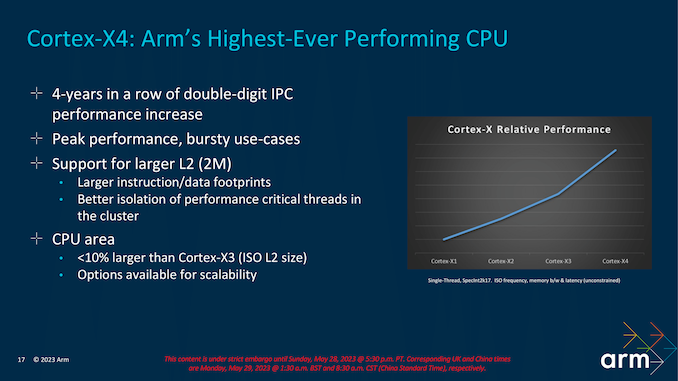
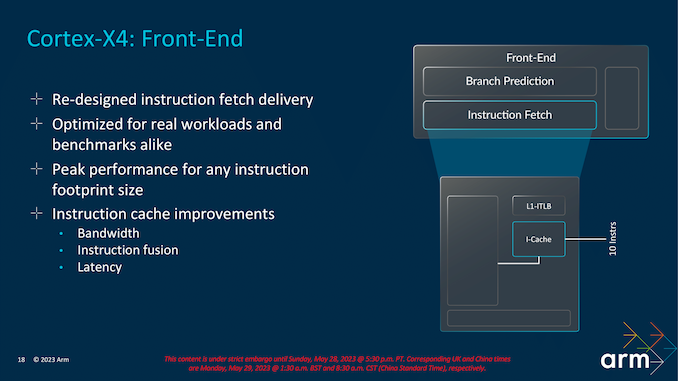

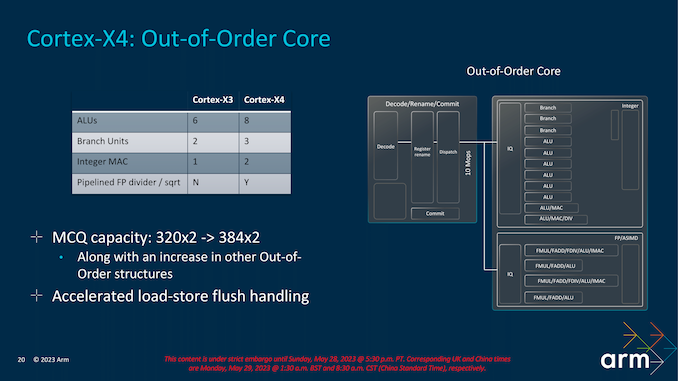
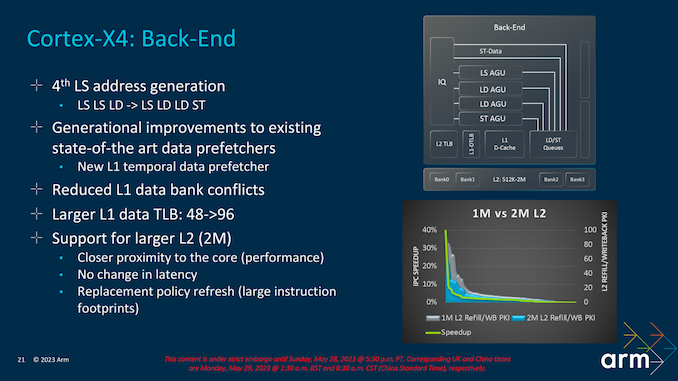
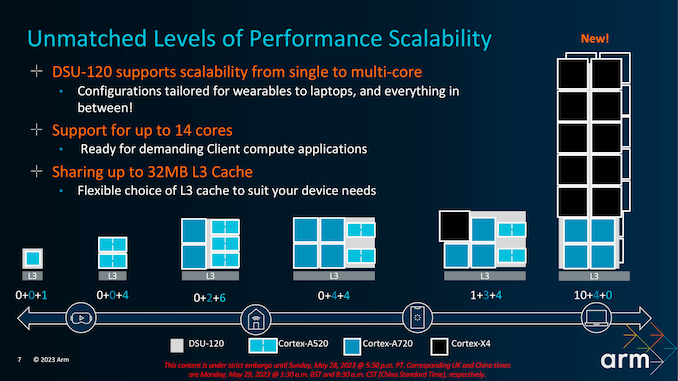
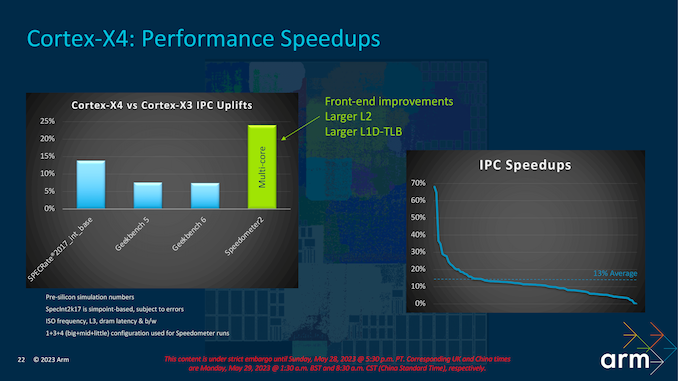








52 Comments
View All Comments
Doug_S - Tuesday, May 30, 2023 - link
Yes TSO is a mode, which requires a setting IN THE ISA to be able to enable it. That setting does not exist on ARM CPUs, only on Apple Silicon implementations.abr2 found what I didn't have time to look for in the ARMv8 architecture reference manual proving your ridiculous claim that ARMv8 required AArch32 support was wrong. Now you're picking on nits trying to twist my words as if I was claiming TSO is an instruction. Give it up you are wrong, everyone knows it, go away quietly instead of making yourself look like even a bigger fool.
dotjaz - Tuesday, May 30, 2023 - link
And your understanding of ARMv9 is abysmal at best. ARMv9-A made Aarch32 EL0 optional, it wasn't possible in ARMv8-A. There is no special license or "something like that".Chelgrian - Tuesday, May 30, 2023 - link
It has been possible an architecturally permissible since ARMv8.0 to create an AArch64 only implementation. If AArch32 is not supported at a particular exception level then setting the M[4] bit in the SPSR and executing an ERET instruction to that level will produce an illegal exception return exception. Combined with designing the system to only reset in to AArch64 at the highest implemented exception level gives you an AArch64 only design.This tangentially referred to in rule R-tytwb in section D1.3.4 of revision J.a of the ARM Architecture Reference Manual.
A conformant ARMv8.x implementation can (but it not mandated to) implement AArch32 at any exception level.
A conformant ARMv9.x implementation may only implement AArch32 at EL0. This is documented in section 3.1 of revision J.a of the ARM Architecture Reference Manual.
There are even documented ARMv8.1 processors out there which are AArch64 only for example the Cavium ThunderX2
https://en.wikichip.org/wiki/cavium/thunderx2
"Only the 64-bit AArch64 execution state is support. No 32-bit AArch32 support."
abr2 - Tuesday, May 30, 2023 - link
From:Arm® Architecture Reference Manual
Armv8, for Armv8-A architecture profile
[2021 version]
D1.20.2 Support for Exception levels and Execution states
Subject to the interprocessing rules defined in Interprocessing on page D1-2525, an implementation of the Arm architecture could support:
• AArch64 state only.
• AArch64 and AArch32 states.
• AArch32 state only.
techconc - Thursday, June 8, 2023 - link
@dotjaz - You don’t know what you’re talking about. The Apple A7 chip supported both A32 and A64 instruction set. By the A11 (in 2017), Apple dropped A32 instruction set and was 64bit only.dotjaz - Tuesday, May 30, 2023 - link
> I'm very fairly certain of this, but if you know something I don't? (I might not..)You are clearly wrong, no ARM licensees can alter ARM ISA in any way. That's the fundation of ARM's licensing terms. And that's the sole reason Apple's AMX extention is masked as undocumented "co-processor" not available to anyone. Even if you knew nothing about the fundamental licensing terms, you should be able to figure that out because if this.
name99 - Monday, May 29, 2023 - link
Jesus. The levels of delusion that are required to write a comment like this.You really think that
(a) ARM is going to make a big deal about Apple being, in some legalistic sense, "non-compliant" AND
(b) that Apple gives a fsck?
Exactly who do you think gets hurt if Apple are not allowed to call APPLE SILICON (note that branding...) Arm Compliant?
Wereweeb - Tuesday, May 30, 2023 - link
Lmao apple fanboys still as hilarious and ignorant as alwaysSilver5urfer - Sunday, May 28, 2023 - link
So much of this nonsensical 64Bit bs. Esp in the name of security, News Flash - Qualcomm EDL mode exists and thankfully it helps the folks to unlock their Bootloaders.The whole 64Bit thing killed the passion on Android. Google just enforces it brutally by n-1 where n being the latest API SDK, thus making all the old apps go obsolete. Windows and x86 excels massively just because of this, Apple did it because they always want to control everything which they do, and the stupid Google just copies them in hoping to make same but they killed all fun on android now, the UI is so boring garbage and the whole Filesystem nerfs - Scoped Storage, lack of proepr SD Card app support and a ton of other APIs blacklisted. Limited the scope of foreground and background apps utilizing the hardware of a phone.
What's the use of the ARM processor devices, when your latest and greatest X4 ARM phone will be outdated in 1 year and goes to dumpster after 2-3 years max. Non Removable, non serviceable, no longevity of the OS / HW / Software. Locked like chastity belt for the User tinkering when the core OS, the Kernel runs Linux. A big L to consumers and all that Environment jabber is literally just a worthless cacophony. Literally you have latest V30 class Micro SDs and SD Association even had PCIe / NVMe SSD class but since not a single $1000-$2000 Android phone pushes forward for a real computer in pocket, its rather a spybox and a mere 2FA device with some Navigation, Social Media, Camera attached.
All this ARM tech is only useful if your device Software API can open it up properly and used a proper pocket computer. But that ship has sailed. All that X4 processing power and multi core non homogeneous compute wasted on basic consumables.
rpg1966 - Monday, May 29, 2023 - link
Could you explain how the UI is affected by the bitness of the OS?